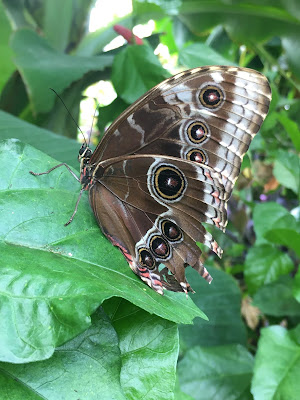I am still playing catch-up so these moths are a bit since, mostly from the last week of August when the grandchildren were here for a week. I was very pleased that this little jewel of a regular came to see them: the Gold Spot (or possibly the imperceptibly different Lempke's Gold Spot). It likes 'damp places including canals and rivers' according to the Moth Bible and we have the Oxford Canal and River Cherwell within quarter of a mile of us. So it must feel at home.
Another shapely and interesting arrival was the Dusky Thorn below whose caterpillars like ash but are prepared to fall back on privet, a useful insurance policy in the event of problems such as ash die-back. I have often wondered why some moth larvae are so faddy when being omnivorous has so much to recommend it (as I constantly tell the sceptical grandchildren).
It was good to have some local examples of colourful and interesting moths because we decided to pay a visit to Blenheim Palace's excellent butterfly house which keeps an excellent number and range of species. Here are some of them. When I have a bit more time, I will see if I can sort them out from one of my intimidatingly large global reference books - or perhaps the internet where searches such as 'black and white swallowtailed butterfly' often produce very rapid answers.
Actually, I just tried that but without immediate success. I do know the next one, however, the Owl Butterfly with its enormous 'eye' which I take to be an effective deterrent against jungle predators. A lot of experiments have been done on this, many suggesting that the eyes resemble those of lizards and other hunters while some suggest that they may divert a bird's attention and subsequent attack away from the insect's body to less crucial places such as the edges of the wings.
Back at home, we found an interesting example of way that the colour green fades in moths, as I mentioned in my last post with reference to the Light Emerald. Here are two Yellow-barred Brindles, the first an older one whose colour has faded (albeit making the moth more in tune with its name). The second is fresh and still delightfully green









No comments:
Post a Comment